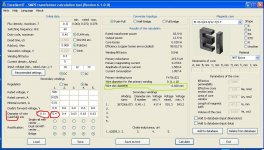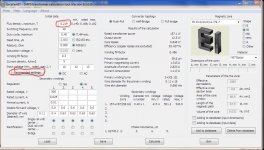Hi the secondary wire isn´t bigger than the primary one because there is written 0.11mm x 18 and that means that you have the 0.11mm wire 18 times in parallel
and only one strand of 0.4mm wire for secondary. 0.11mm 18 times is bigger than just one strand 0.4mm wire. You have to see 0.11mm wire as added diameter because it´s in parallel. You can´t use just one big piece of primary wire because of skin effect, if you thought why the program uses 0.11mm 18 times it´s the skin effect that makes all things worse.
and only one strand of 0.4mm wire for secondary. 0.11mm 18 times is bigger than just one strand 0.4mm wire. You have to see 0.11mm wire as added diameter because it´s in parallel. You can´t use just one big piece of primary wire because of skin effect, if you thought why the program uses 0.11mm 18 times it´s the skin effect that makes all things worse.
Last edited:


